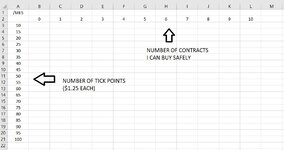Malthus101
New Member
- Joined
- Jan 23, 2017
- Messages
- 46
- Office Version
- 2016
- Platform
- Windows
Howdy!
So... trading of futures contracts - /MES in this case (micro S&P futures)
Tick value is $1.25 - 1 contract is $5 (4 ticks per contract)
Max risk is dynamic value but lets call it $50.
So I need to create an "at a glance" matrix that will tell me how many contracts to buy when the stop/risk, is a certain number of ticks.
So for example, if the stop/risk was 40 ticks away ($1.25 x 40 = $50) then I could buy 1 contract safely.
If the stop/risk was 80 ticks away ($1.25 x 80 = $100) then I could not buy any contracts safely, so could not enter the trade.
If the stop/risk was 20 ticks away ($1.25 x 20 = $25) then I could buy 2 contracts safely and still only lose $50 if stopped out.
So... I already have one sheet programmed to make calculations for correct position size, that I must manually enter the data for each trade on.
However, this is time consuming in a fast moving environment.
I want to create another sheet, that references the first sheet, and presents the information as a simple matrix.
Increments of 5 would work best I feel.
10 ticks, 15 ticks, 20 ticks etc. This would be column A.
Column B would be for 0 contracts
Column C would be for 1 contracts.
Column D would be for 2 contracts.
Continue this to a maximum of 10 contracts.
The matrix would simply be colored cells so I can see what the max number of contacts I could buy for the number of ticks/risk for the trade.
So I need a formula in each cell that calculates number of ticks x the tick value = "number". If that number is 50, it will give me a green box under "1 contract"
If the number is say 75 (too much risk) it would turn the cell red in Column C (0 contracts allowed)
If the number were say 25, it would turn the 25 row and column D (2 contracts) cell green.
To make matters even more complicated, I am OK with it rounding the numbers up (absorb a little more risk) but I would like it to be within say a 20% range of the risk amount ($50)
So if the potential loss was $60, I am OK with that. But if it was $65, that's now too much.
Being not only bad at Excel but also terrible at math, I hope I have explained this clearly enough!
Thanks!
So... trading of futures contracts - /MES in this case (micro S&P futures)
Tick value is $1.25 - 1 contract is $5 (4 ticks per contract)
Max risk is dynamic value but lets call it $50.
So I need to create an "at a glance" matrix that will tell me how many contracts to buy when the stop/risk, is a certain number of ticks.
So for example, if the stop/risk was 40 ticks away ($1.25 x 40 = $50) then I could buy 1 contract safely.
If the stop/risk was 80 ticks away ($1.25 x 80 = $100) then I could not buy any contracts safely, so could not enter the trade.
If the stop/risk was 20 ticks away ($1.25 x 20 = $25) then I could buy 2 contracts safely and still only lose $50 if stopped out.
So... I already have one sheet programmed to make calculations for correct position size, that I must manually enter the data for each trade on.
However, this is time consuming in a fast moving environment.
I want to create another sheet, that references the first sheet, and presents the information as a simple matrix.
Increments of 5 would work best I feel.
10 ticks, 15 ticks, 20 ticks etc. This would be column A.
Column B would be for 0 contracts
Column C would be for 1 contracts.
Column D would be for 2 contracts.
Continue this to a maximum of 10 contracts.
The matrix would simply be colored cells so I can see what the max number of contacts I could buy for the number of ticks/risk for the trade.
So I need a formula in each cell that calculates number of ticks x the tick value = "number". If that number is 50, it will give me a green box under "1 contract"
If the number is say 75 (too much risk) it would turn the cell red in Column C (0 contracts allowed)
If the number were say 25, it would turn the 25 row and column D (2 contracts) cell green.
To make matters even more complicated, I am OK with it rounding the numbers up (absorb a little more risk) but I would like it to be within say a 20% range of the risk amount ($50)
So if the potential loss was $60, I am OK with that. But if it was $65, that's now too much.
Being not only bad at Excel but also terrible at math, I hope I have explained this clearly enough!
Thanks!






